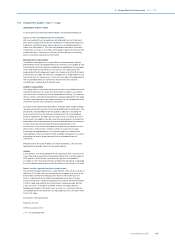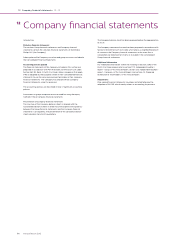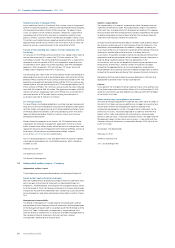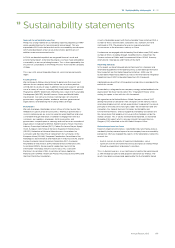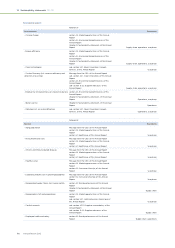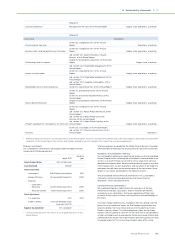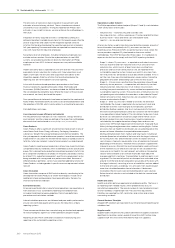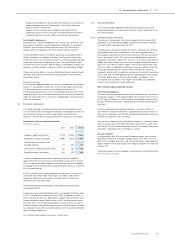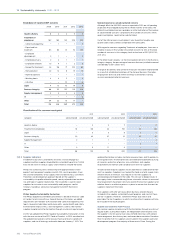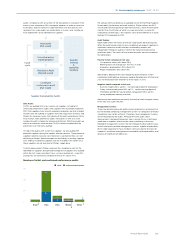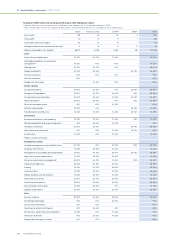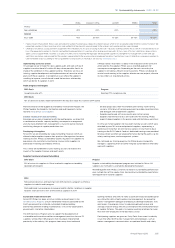Philips 2013 Annual Report Download - page 197
Download and view the complete annual report
Please find page 197 of the 2013 Philips annual report below. You can navigate through the pages in the report by either clicking on the pages listed below, or by using the keyword search tool below to find specific information within the annual report.
13 Sustainability statements 13 - 13
Annual Report 2013 197
13 Sustainability statements
Approach to sustainability reporting
Philips has a long tradition of sustainability reporting, beginning in 1999
when we published our first environmental annual report. This was
expanded in 2003, with the launch of our first sustainability annual report,
which provided details of our social and economic performance in
addition to our environmental results.
In 2008, we decided to publish an integrated financial, social and
environmental report, reflecting the progress we have made embedding
sustainability in our way of doing business. This is also supported by the
inclusion of sustainability in the Philips Mission, Vision and the company
strategy.
This is our sixth annual integrated financial, social and environmental
report.
Tracking trends
We continuously follow external trends to determine the issues most
relevant for our company and those where we can make a positive
contribution to society at large. In addition to our own research, we make
use of a variety of sources, including the United Nations Environmental
Programme (UNEP), World Bank, World Business Council for Sustainable
Development (WBCSD), World Economic Forum and World Health
Organization. Our work also involves tracking topics of concern to
governments, regulatory bodies, academia, and non-governmental
organizations, and following the resulting media coverage.
Stakeholders
We seek to engage stakeholders across all our activities to gain their
feedback on specific areas of our business. Working in partnerships is
crucial in delivering on our vision to make the world healthier and more
sustainable through innovation. In addition to engagement with our
customers, our suppliers, employees, local communities and
governments, we participate in meetings and task forces as a member of
organizations including the WBCSD, World Economic Forum, Electronic
Industry Citizenship Coalition (EICC), Carbon Disclosure Project Supply
Chain, European Committee of Domestic Equipment Manufacturers
(CECED), Federation of National Manufacturers Associations for
Luminaires and Electrotechnical Components for Luminaires in the
European Union (CELMA), European Coordination Committee of the
Radiological, Electromedical and Healthcare IT Industry (COCIR), Digital
Europe, European Lamp Companies Federation (ELC), European
Roundtable of Industrialists (ERT), National Electrical Manufacturers
Association (NEMA), Environmental Leadership Council of the
Information Technology Industry Council (ELC ITIC), Consumer
Electronics Association (CEA), Association of Home Appliance
Manufacturers (AHAM), Healthcare Plastics Recycling Council (HPRC) and
the Ellen MacArthur Foundation.
A multi-stakeholder project with the Sustainable Trade Initiative (IDH), a
number of NGOs, and electronic companies was started in 2011 and
continued in 2013. The program focuses on improving working
circumstances in the electronics industry in China.
Furthermore, we engaged with the leading Dutch labor union (FNV) and a
number of NGOs, including Enough, GoodElectronics, MakeITfair, the
Chinese Institute of Public and Environmental Aairs, SOMO, Amnesty
International, Greenpeace and Friends of the Earth.
Reporting standards
In this report, we have followed relevant best practice standards and
international guidelines while reporting on our sustainability performance.
Most important are the Global Reporting Initiative’s (GRI) new G4
Sustainability Reporting Guidelines as well as the International Integrated
Reporting Council (IIRC) Integrated Reporting <IR> framework.
A detailed overview of the G4 Comprehensive Indicators is provided at the
end of this section.
Sustainability is integrated in our company strategy and embedded in the
organization. We have tried to reflect this “integrated thinking” while
writing this report, in line with the <IR> framework.
We signed on to the United Nations Global Compact in March 2007,
joining thousands of companies from all regions of the world as well as
international labor and civil society organizations to advance 10 universal
principles in the areas of human rights, labor, the environment and anti-
corruption. Our General Business Principles, Sustainability and
Environmental Policies, and our Supplier Sustainability Declaration are
the cornerstones that enable us to live up to the standards set by the
Global Compact. This is closely monitored and reported, as illustrated
throughout this report, which is also our annual Communication on
Progress (COP) submitted to the UN Global Compact Office.
Material aspects and our focus
Based on ongoing trend analysis, stakeholder input and media analysis,
we identify the key material aspects for our company from a sustainability
perspective. We have mapped the aspects in the table below, taking into
account the:
• level of concern to society at large and stakeholders, versus
• significance of the environmental and social impact on and by Philips
through our operations and products/solutions.
This is a dynamic process, as we continuously monitor the world around
us. We develop our policies and programs based on our findings. The
results have been reviewed and approved by the Sustainability Board.




